Captain Trollope and the Carronades – Part 2
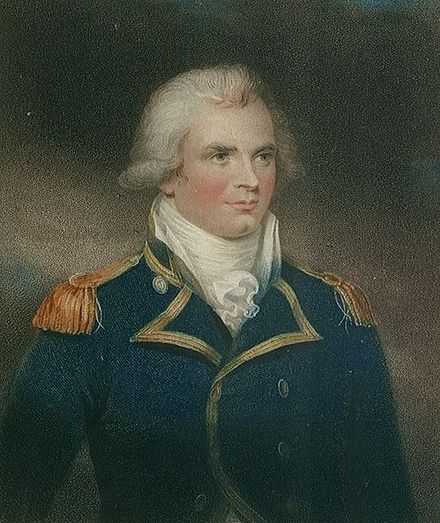
Henry Trollope
In Part1 of this article (Click here to read it if you missed it) we met the “carronade crazy” Royal Navy officer Henry Trollope (1756-1839). His career was a distinguished one – he rose to full Admiral – but his long-term reputation rests on two spectacular actions in which carronades played a decisive role. Part 1 describes these large-bore but short-range weapons, which represented cutting-edge technology from the 1780s onwards, and Trollope’s brilliant use of them when he commanded HMS Rainbow in the last years of the American War of Independence.
The gap between the American War – in which France, as usual, sided against Britain – and the next conflict Britain would fight with France, the Revolutionary War, was a short one, just a decade long. In this decade however the British government did what governments have done through history – once victory was gained it was assumed that no further conflict was likely in the near future and that economic advantage could be achieved by standing down armed forces, disposing of warships and running down stores. This was to offer what is now called a “peace dividend”. It was to prove an illusion once revolution erupted in France and launched more than two decades of warfare on a global scale. Britain’s new was began in early 1793 and by then large numbers of warships that had proved so essential in the earlier conflict had by now been disposed of. More ships were needed –and as soon as possible. New construction was immediately committed to but, until these vessels were completed and commissioned, stopgaps were essential.
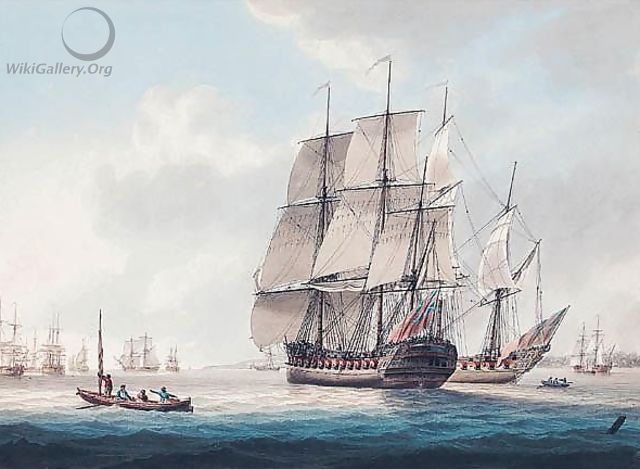 East Indiaman Woodford by Samuel Atkis (1787-1808) (with acknowledgement to the WikiGallery.org)
East Indiaman Woodford by Samuel Atkis (1787-1808) (with acknowledgement to the WikiGallery.org)
One such stopgap measure was to purchase ten “East Indiamen” – stoutly built trading vessels in the service of the East India Company and well suited to long ocean voyages. Typical of these was HMS Glatton, a 1253-ton ship, pierced with gun ports like all of her kind and carrying defensive armament to protect her against Algerine corsairs off North Africa and other pirates in Eastern Seas. By the time she was requisitioned by the Royal Navy in 1795, she had already participated in the capture of a French brig, Le Franc, while part of a trading convoy. On being taken into the Navy, command of her was assigned to Captain Henry Trollope, who had the responsibility for arming and commissioning her, and getting her into service as soon as possible. Trollope, building on his previous experience, made maximum use of the latitude allowed him and he armed HMS Glatton entirely with carronades rather than with the usual mix of long guns. A total of twenty-eight 68-pounder carronades were mounted on the lower deck and twenty-eight 32-pounder carronades on the upper. All were on slides rather than trucks but the vessel’s gun ports were too small to allow training other than on the beam. Added to this was the fact that the deck layout did not allow mounting of bow-chasers or stern-chasers. Careful manoeuvering of the entire ship would therefore be needed to bring her massive firepower to bear.
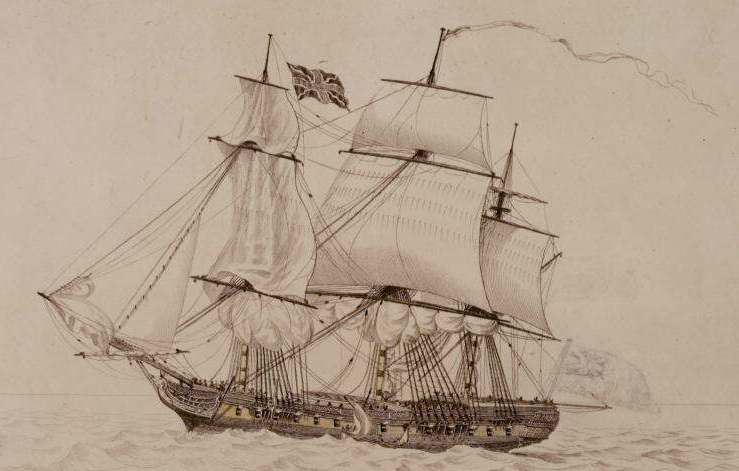
East Indiaman – contemporary engraving
Classed as a fourth-rate, HMS Glatton was assigned to the North Sea Fleet, under Admiral Adam Duncan. On the 14th July 1795, she was directed to sail to join a squadron of two ships of the line and several frigates cruising off the Dutch coast, the Netherlands being by this stage a French satellite. In the early afternoon of the 16th, close to the Dutch naval base of Helevoetsluis, Trollope and HMS Glatton sighted a powerful enemy squadron. This consisted of consisted of six large frigates, a brig, and a cutter. One of these, as far as could be made out, mounted 50 guns, two 36, and the other three 28. Given these odds, Trollope might be forgiven for judging discretion to be the better part of valour. He banked however on the same advantage that had proved so decisive in his earlier action with HMS Rainbow – the surprise element and the devastating firepower of the carronades if the range could be closed. He therefore ordered HMS Glatton to be cleared for action and steered towards the enemy.
It was now late evening, though still light, when Trollope drew level with the third ship in the enemy’s line. That he was allowed to come so close is a mystery, as is the fact that the enemy was so rigidly attached to line tactics in the circumstances. Trollope hailed this third ship, and confirming that she was French, ordered her commander to strike his colours. Instead of doing so, the Frenchman not surprisingly responded with a broadside. HMS Glatton, at a separation of only thirty yards, unleashed her own broadside, one comparable to that of a ship of the line. The other enemy ships now – at last – manoeuvred to surround HMS Glatton, the two headmost vessels tacking about so that one placed herself alongside to windward, and the other on HMS Glatton’s bow, while the remaining ships engaged her on her lee-quarter and stern.
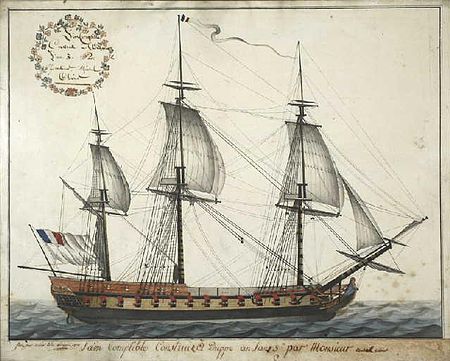 French frigate Incorruptible – one of Glatton’s opponents
French frigate Incorruptible – one of Glatton’s opponents
HMS Glatton’s awesome firepower was mitigated by the fact that her crew was insufficient to man her guns on both sides simultaneously. The solution was to divide each gun-crew into two gangs. One loaded and ran out the gun, leaving the most experienced hands to aim and fire it while they rushed across and loaded and ran out the gun on the opposite side. Fire was now continuous, the range on each side so close that HMS Glatton’s yard-arms were nearly touching those of the enemy. Her carronades were by now inflicting serious damage and the French commodore tried to decide the issue by having his lead ship attempt to drive Glatton on to a nearby shoal. By skilful manoeuvring, Trollope tacked to avoid this and while the French vessel was herself doing the same he managed to rake her. His own masts yards and sails were by now badly damaged and though further damage was inflicted on the enemy it proved impossible to manoeuvre effectively to bring his cannonades into play. The enemy vessels stood off as darkness fell and through the night Trollope’s crew was occupied in strengthening masts and yards, and in bending fresh sails. By daylight, Glatton was in a fit state to renew the action – and the light also revealed that the enemy squadron was now running for the protection of the port of Flushing. Trollope followed for two hours but as he had no hope of reinforcement, and as the wind was blowing on shore, he was compelled to haul off and steer for Yarmouth Roads, where he arrived on the 21st.
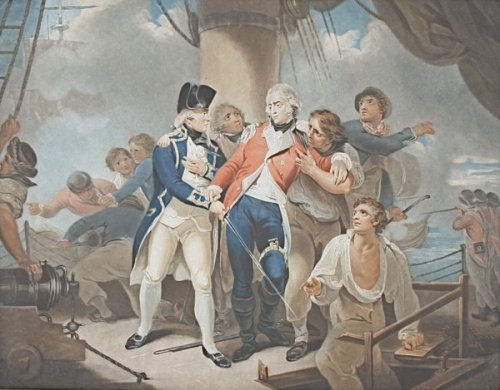 Trollope with the mortally wounded Marine Captain Henry Ludlow Strangeways on HMS Glatton
Trollope with the mortally wounded Marine Captain Henry Ludlow Strangeways on HMS Glatton
It was subsequently found that all the enemy ships had been badly damaged, one sinking in Flushing harbour after arrival. The largest, with which HMS Glatton was chiefly engaged, was the Brutus, a “74” 300 tons larger and cut down to some 50 guns, of which 46 were 24-pounders. Also present were the frigates Incorruptible, Magicienne and Républicaine. Perhaps the most remarkable aspect of the action was that although the French losses must have been heavy (though undetermined), Glatton’s casualties were two wounded only, one of whom, the captain of Marines, died subsequently.
Trollope’s achievement was immediately recognised as unprecedented. He had deliberately engaged six other powerful ships simultaneously, and had put them to flight. He was rewarded with a well-deserved knighthood. He was to retain command of HMS Glatton for three more years, still in the North Sea fleet, and one of his notable achievements was persuading her crew not to join the Nore mutiny in 1797. He went further – by threatening to unleash Glatton’s firepower on two other ships that were in open mutiny, he induced their crews to return to duty. Promoted to command of the “74” Russell, he was to participate in Duncan’s victory at Camperdown later the same year.
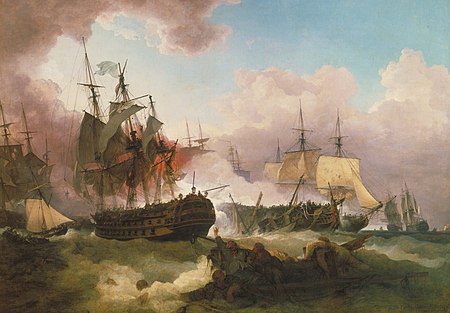
The Battle of Camperdown, painted by Philip de Loutherbourg (1740-812).
And Glatton? She was converted in due course the more conventional armament – her “carronades-only” surprise value could only be of limited duration – and she was to see extensive action in the North Sea, Baltic and the Mediterranean until being hulked for harbour service in 1814.
Like naval fiction? Try Britannia’s Wolf
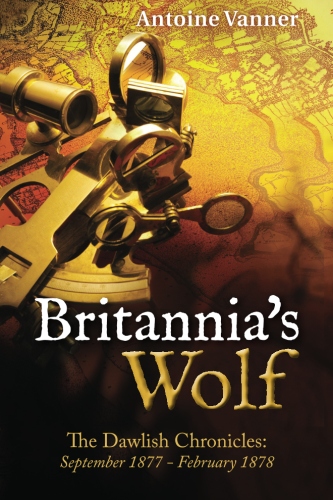 It’s 1877 and the vicious Russo-Turkish War is reaching its climax.
It’s 1877 and the vicious Russo-Turkish War is reaching its climax.
A Russian victory will pose a threat to Britain’s strategic interests. To protect them an ambitious British naval officer, Nicholas Dawlish, is assigned to the Ottoman Navy to ravage Russian supply lines in the Black Sea. In the depths of a savage winter, as Turkish forces face defeat on all fronts, Dawlish confronts enemy ironclads, Cossack lances and merciless Kurdish irregulars, and finds himself a pawn in the rivalry of the Sultan’s half-brothers for control of the collapsing empire. And in the midst of this chaos, unwillingly and unexpectedly, Dawlish finds himself drawn to a woman whom he believes he should not love.
Neither for his own sake, nor for hers…
Britannia’s Wolf features a naval hero who is more familiar with steam, breech-loaders and torpedoes than with sails, carronades and broadsides. Dawlish joined as a boy a Royal Navy still commanded by veterans of Trafalgar but he will help forge the Dreadnought navy of Jutland and the Great War. Other books in the series follow him further along that path. Click here, or on the cover image, for more details.



